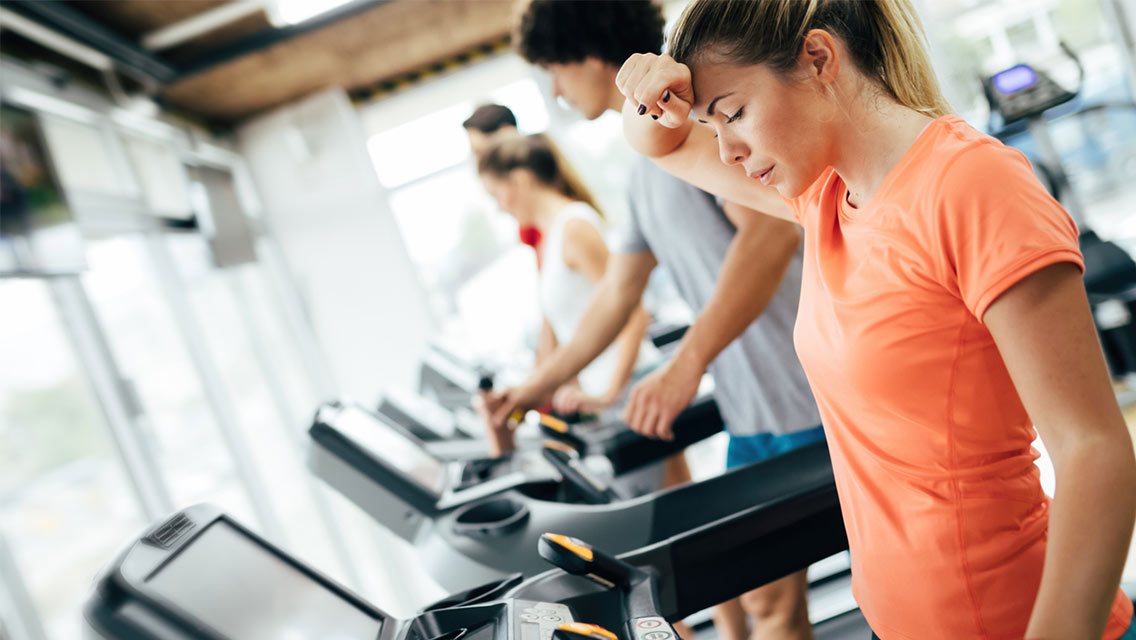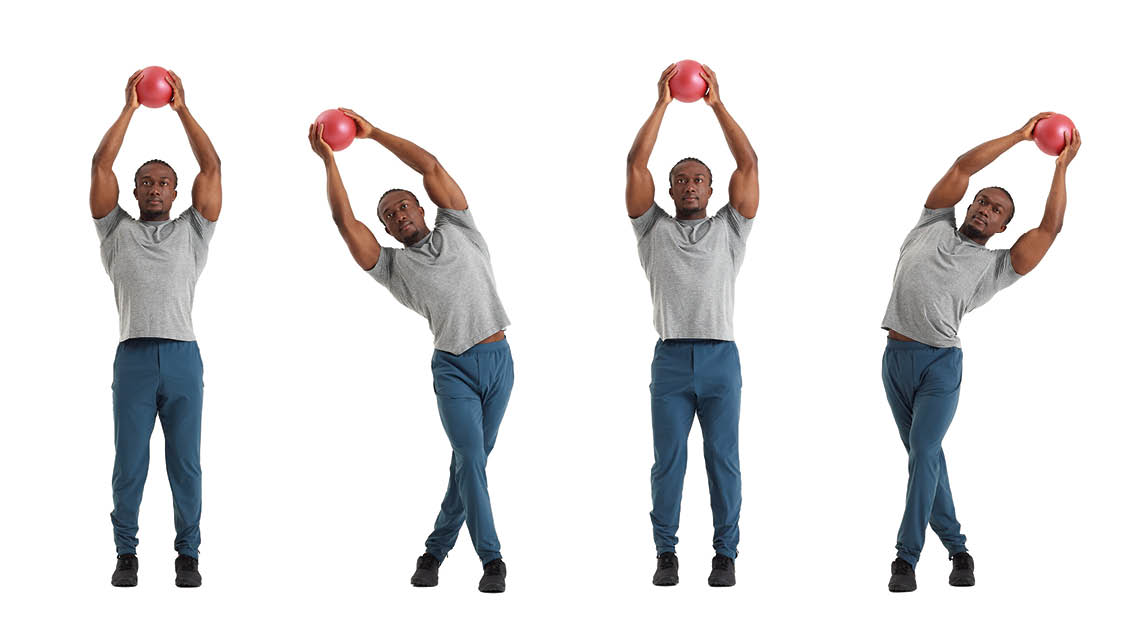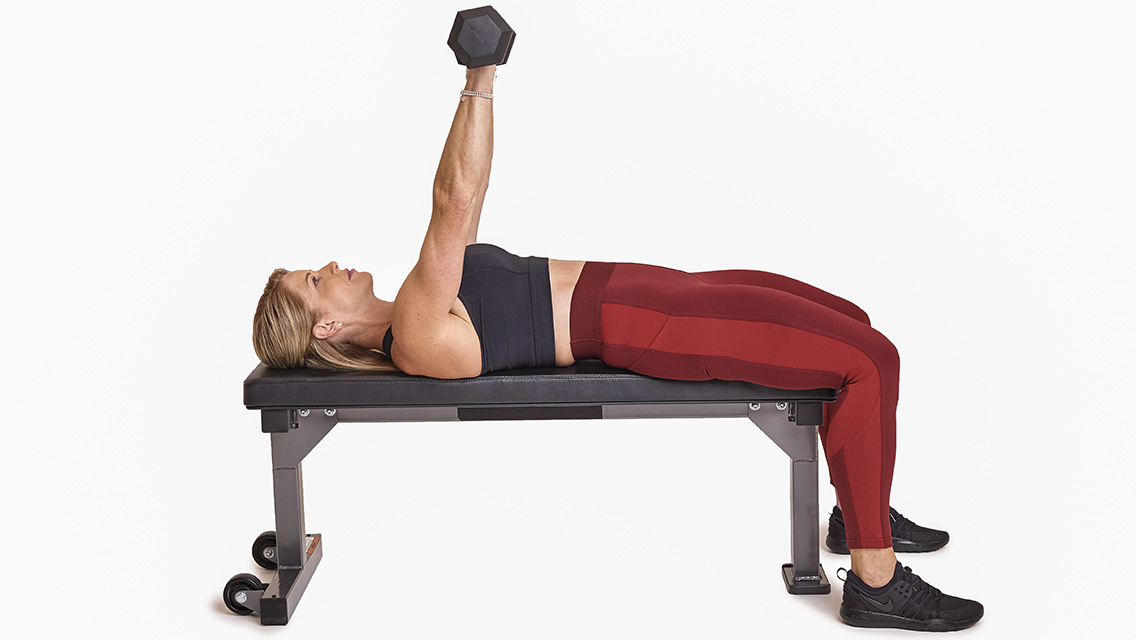When we work out, many of us cheat without knowing it. On the cardio machines, it might be something as innocent as locking your elbows while leaning on the handrails. In the weight room it may be the use of momentum, or a slight change in the angle of your back, that makes a lift easier — and, unfortunately, less effective.
Are you a gym cheater? To help you find out for sure, we’ve identified some of the most common exercise cheats and provided suggestions for breaking any bad habits you might have, ahem, accidentally fallen into.
Leaning on Cardio Machines
The Cardio Machine Cheat:
When you feel fatigued on the treadmill or StairMaster, it’s tempting to grab the console for support. “But every time you use a crutch to reduce the effort of an exercise, you also diminish its benefits,” says Mark Coberley, ATC, CSCS and head athletic trainer at Iowa State University. “Since it’s natural to try to avoid doing hard work when you become tired, we ask our athletes not to use the handles at all. Then they see improvements quickly because they’re doing more work.”
Leaning too heavily on the cardio machines can also cause you to slouch. “Stair climbing, walking, cycling, or running in an awkward, unnatural posture can put added stress on your back and, over time, create muscular imbalances that are difficult to correct,” says Tom Green, a chiropractor in Lincoln, Neb. Although most of us begin our exercise sessions feeling strong and striding with perfect posture, as we tire, our comfort-driven instincts kick in to relieve the strain. When you couple fatigue with distractions, such as looking down to read or up at the television, the shift from a healthy posture to a downright ugly one can quickly occur.
Beat the Cheat:
To maintain a healthy posture, always look straight ahead, keep your spine erect, shoulders back and chest forward. When running:
- Your body weight should be balanced so you land on the arch and ball of your foot with each stride.
- Your elbows should be bent at 90 degrees and kept close to your body.
- Touch the handrails lightly with the tips of your fingers to maintain balance, but when you find yourself shifting your weight onto your arms for support, slow your pace until your strength returns, then resume your workout tempo. If it becomes too difficult to maintain good posture for an extended period, move from one aerobic machine to another.
For example, complete a half-hour session running on the treadmill, then switch to the exercise bike for 10 minutes and the StairMaster for another 10 minutes. As you continue to focus on your posture, you’ll gradually strengthen your back, abdominal and shoulder muscles. As a result, you’ll more easily hold your torso erect and avoid the lure of the handrails.
Shortening Your Stride
The Treadmill Cheat:
Just as you wouldn’t tiptoe around the running track, or take baby steps crossing the street in rush-hour traffic, you don’t want to go shortening your steps on the treadmill or most other aerobic machines. Instead, take long, even steps or strides. Sure, it might look like you’re working harder by taking a bunch of smaller, faster steps, but you’re actually limiting your movements to the narrow range in which your muscles are strongest. Thus, “you avoid developing strength in your weaker areas, where it’s most needed,” says Coberley.
Beat the Cheat:
To improve your stride, try exaggerating your steps in slow motion:
- Lift your knee high and focus on extending the landing foot back, rather than on overreaching with the forward leg.
This applies equally to stair climbing, walking, running and cross-country skiing. Elite athletes lift the forward knee quickly to achieve maximum length in the trailing leg, which propels the body forward through a triple extension of the hip, knee and ankle. You might find that this requires greater effort at slower speeds than quick, shallow steps, but as you improve the overall pace of your workouts, you’ll discover that a full stride makes it easier to sustain speed over longer bouts of exercise.
Lifting Weights Too Quickly
Weight Lifting Cheat #1:
You might think lifting more weight means faster results. But often, when you use your momentum to heave and swing your dumbbells instead of lifting them in a smooth fashion, you take the work off the muscles you are trying to develop. Besides cheating yourself out of a good workout, these jerky movements can also easily cause you to sprain a muscle or strain a joint. (Read more about proper lifting tempo in “Fitness Fixes“.)
Beat the Cheat:
Instead of swinging your weights, keep your spine erect, move only the targeted muscle and keep the occupied joint fixed in space. For example:
- if you’re performing a curl, don’t arch your back and lift your shoulders.
- The only movement should occur at the elbow, and it should stay pinned beside your rib cage.
Male egos notwithstanding, it’s not the same to curl 85 pounds with a hip thrust and a back bend as curling the same weight in strict form using only your biceps. Instead of trying for a few forced reps, do a “drop set”: Perform as many reps as you can with a given weight and then immediately reduce the poundage and repeat the exercise. Continue dropping the weight without resting in between sets until you complete four or more sets of six to eight repetitions each.
Shortening Your Lifts
Weight Lifting Cheat #2:
When you lift, you’ll notice that it’s easier to move the weight along certain segments of its travel path and more difficult at others. Trainers refer to the hardest segment as the “sticking point.” For example:
- When you perform a biceps curl, the lift feels easiest when your elbow is flexed at 90 degrees and hardest when your arm is fully extended.
- We have a natural tendency to move the weight along the easiest travel path, avoiding the sticking points.
Watch someone perform curls and you’ll often see him or her move the bar along a shortened range from about 135 degrees to 45 degrees. Likewise, most squatters stop short of having their thighs parallel to the floor. Exercisers on the leg-curl machine often don’t extend their knees fully or tuck the weight up close to their butt at the end of every repetition.
Beat the Cheat:
The tendency toward shortening your lifts usually comes as you move toward heavier weights. But heavy resistance with limited range of motion decreases your flexibility, which is why many lifters develop serious stiffness. Your muscles are good students: They learn whatever you train them to do. If you move your limbs through their complete range, from full extension to full contraction, they will develop fully and evenly. If you work in only a shortened range, where you feel strongest, your muscles will accommodate this requirement bywell, becoming shorter.
Excessive Moderation
The Cheat:
Many of us become comfortable doing the same workout at the same pace without increasing the workload. Sometimes it’s because we’ve become lazy and don’t want to exert a greater effort; often it’s because we’re not really sure how to increase the workload. But your body only improves by gradually adapting to increased stress, which is why exercise makes you stronger. “If you never stretch your limits, you won’t improve,” says Coberley.
Beat the Cheat:
Challenge your body at least three times a week by working slightly beyond your normal comfort zone. “Add a level of difficulty by increasing the speed, incline or resistance so you experience at least a moderate level of exertion,” says Cole Maranville, an ACE-certified personal trainer in Lincoln, Neb. Begin by pushing for an extra minute or so on the aerobic machines. If you need to catch your breath, slow down until you regain composure, then speed up again. In this case, a little can go a long way.
Lifting Light
The Light Weight Cheat:
The more times you lift, the stronger you get, right? Wrong. One of the most common exercise frauds is the idea that high repetition with lighter weights allows you to get stronger without bulking up. If anything, the opposite is true. Look at bodybuilders and power lifters.
Bodybuilders use high-rep exercises to increase size, whereas power lifters use low-rep, high-intensity lifts to increase strength.
Exercising with any weight you can lift 20 times or more without feeling fatigued provides almost no strength-building benefit. It does, however, develop endurance, which comes in handy when you perform exercises such as pushups, pull-ups, sit-ups and running. But you don’t want to set a world record for continuous curls, right? To develop strength and better muscle tone you need to lift progressively heavier weights with fewer reps.
Beat the Cheat:
- When you first begin a lifting program, you should use weights light enough to learn the proper movements.
- At this early stage, higher repetitions ranging from 12 to 20 can help you develop the stabilizer muscles that control movement and prepare you for strength building later on.
- Once you have learned how to lift in good form, you should exercise with enough weight to perform only eight to 12 repetitions, squeezing the last two reps with all your might.
By increasing your workload and decreasing the number of repetitions, you will develop your capacity to lift progressively heavier weight. When you find that you can complete eight to 12 reps with a given load without struggling on the final two reps, it’s time to move up. Just keep in mind that when your cadence slows from too much weight, you may have to reduce your load in order to complete the same number of reps.
Workout Dos & Don’ts
- Don’t support your weight on aerobic equipment with your arms.
- Don’t take quick, little steps on the stair climber. Move with full, natural strides.
- Don’t arch your back while lifting.
- Don’t use momentum when lifting for strength. Move the weight slowly, smoothly and deliberately.
- Don’t reduce range of motion to the easy part of a lift.
- Don’t perform endless reps with lighter weights.
- Do focus on posture, keeping your back straight, shoulders and hips squared off, head held high and your face looking straight ahead.
- Do – within reason – test your limits of endurance and strength.
- Do focus on perfect form: Keep your tummy tight, back straight, feet planted.
- Do move your joints through their full arc to preserve flexibility.
- Do work with weights that allow you to complete eight to 12 reps (but the last two should require all your effort).
- Do periodically review your workout to ensure it remains challenging.
This article originally appeared as “Don’t Wimp Out” in the March 2004 issue of Experience Life.




This Post Has 0 Comments